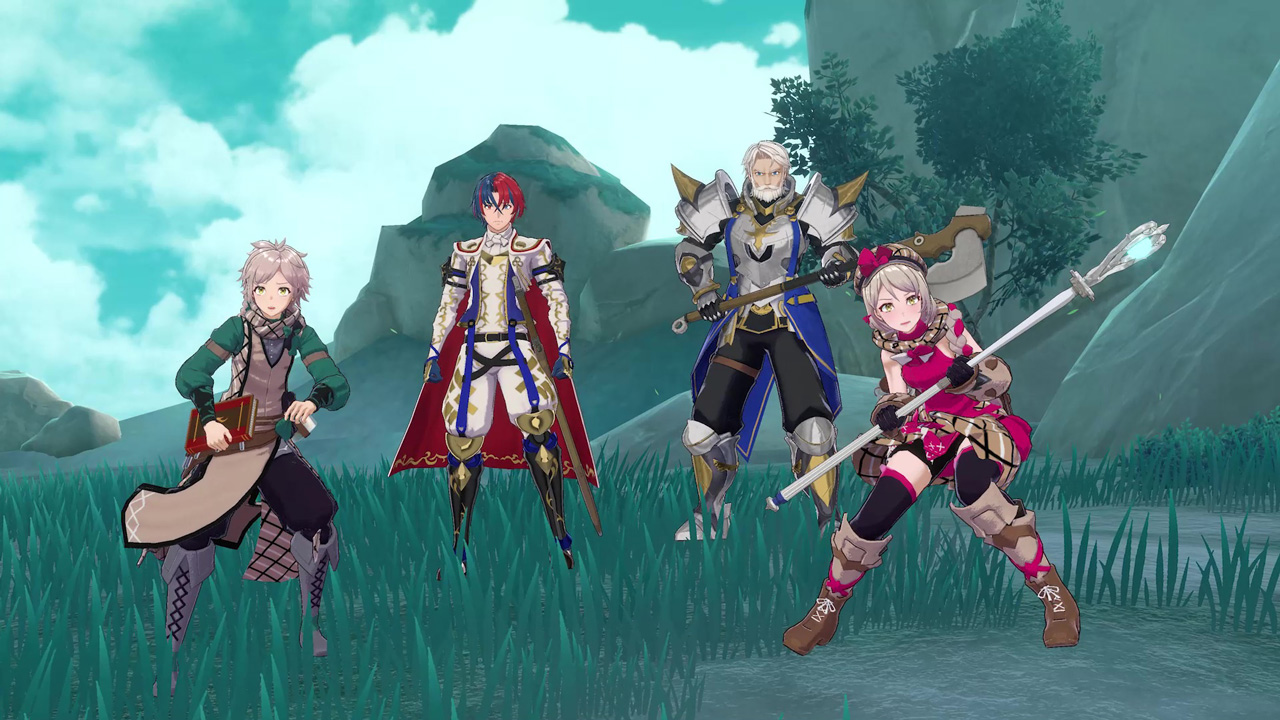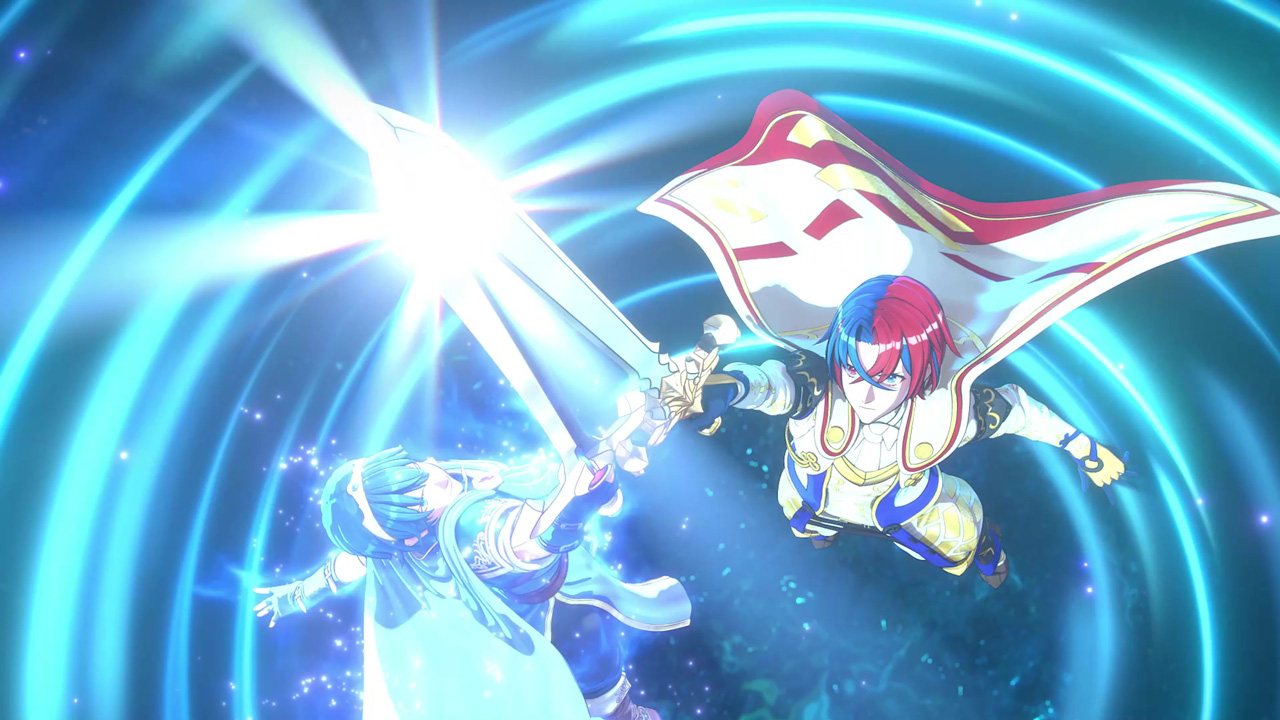Fire Emblem, Engage! *Hums along to the title theme, waving his arms around*, oh sorry, I was too busy reenacting poses from the emblem rings, and I didn’t notice you there. Welcome to our review of Fire Emblem Engage, the latest installment in the Fire Emblem series. And I must say, I haven’t had this much fun with a Fire Emblem title in a long time (and I played both of them!). I haven’t played the warriors title, so sorry – I can’t help you there. If you’re looking for old-school Fire Emblem action, you have come to the right person.
Oke – quick synopsis before we start taking this thing apart since I want to talk about the story a little bit without spoiling the main twists and turns of Fire Emblem Engage covers. Oh, and Nintendo, what’s up with all these protagonists sleeping for 1000 years?
Synopsis
One thousand years ago, the evil Fell Dragon Sombron was sealed away by the Divine Dragon Lumera. Still, during the fighting, Lumera’s child, Alear (Shez in my story), is gravely wounded and put into a slumber. Alear awakens from their slumber one thousand years later and briefly reunites with Lumera. However, Alear has lost most of their memories before falling asleep and can only remember how to use their Emblem Ring, which can summon the spirit Emblem Marth to assist them in battle. In addition, undead creatures called Corrupted to begin to appear all across Elyos, signaling the return of Sombron. An army suddenly attacks Lumera’s castle from the Kingdom of Elusia, which seek to revive Sombron. The Elusians steal most of Lumera’s Emblem Rings, and Lumera sacrifices herself to protect Alear from a sorceress’ attack.
According to Tsutomu Tei, game director from Intelligent Systems, Engage has a story structure simplified compared to the previous title in the series, Fire Emblem: Three Houses, focusing on only one primary goal so that players can focus on tactical gameplay. Genki Yokota, the producer from Nintendo EPD Group No. 2, says that while multiple story paths can be interesting for a game, players might feel its overwhelming, so for this title, they decided on not having more than one path to be played, instead having a focus on one path. However – Fire Emblem Engage still offers a lot of skirmishes, divine paralogues (if you opt for the DLC), and other missions, so even though there’s not that ‘big of a story’ like in Three Houses, this is easily my preferable style of Fire Emblem gameplay.
Gameplay
Aaaaand cut! That’s a wrap folk, classic Fire Emblem storyline, right there. It features everything you need, including Link from the Legend of Zelda: Breath of the Wild, which blows a fresh wind of progress through the series. It’s pretty hard to topple the excellent addition of Three Houses, but Engage leaves its mark on the series to stand out. And yes, that was the final sleeping beauty joke I will make about the protagonist. You get the picture. So, gameplay-wise, it’s still Fire Emblem – and for those unfamiliar with the series, it’s more than sword-wielding red/blue-haired people who got a lot of features in the Super Smash Bros series. Sometimes it’s even a red and blue-haired protagonist that’s not featured in Smash!
Fire Emblem‘s developers have described it as an “RPG simulation,” combining tactical simulation gameplay with the plot and character development of a role-playing game, creating a sense of connection with characters not present in the previous tactical games (At the time of release) Battles in the Fire Emblem series play out on a grid-based map, with the player controlling a set number of characters across maps tied to both the game’s story and optional side stories. Each character has a specific character class, giving them set abilities and affecting how far they can move across the field. Some character classes have innate skills unique to them, and each character has their stats. Depending on the series of installments, a character’s class can be changed or upgraded, sometimes with the requirement of special items. During a battle, each character gains experience points by performing actions, such as attacking an enemy, healing an ally, or slaying a foe (which typically offers the most experience points). When a certain level is reached, the character levels up, and new skill points are awarded randomly to a character’s attributes, such as health, agility, or strength. The more a character is used in battle, the more experience that character gains.
A key element in combat since Genealogy of the Holy War is the Weapon Triangle, a system governing the strengths and weaknesses that certain weapons and types of magic have against each other in a rock–paper–scissors fashion. For weapons, lances are stronger than swords, swords are stronger than axes, and axes are stronger than lances. In the magic system, fire is stronger than wind, the wind is stronger than thunder, and thunder is stronger than fire. It’s also one of those features that make Fire Emblem the strong series it is today since every move needs to be calculated. Why? Because perma-death is always around the corner, except if you’re like me and play games like this in the casual mode because you’re still traumatized by the older Fire Emblem releases.
Emblems
One of my favorite elements of Fire Emblem Engage is the Emblem system, which is much more than Sailor Mooning your heroes. The idea of the Emblem system, according to Kenta Nakanishi, director from Nintendo EPD Group No. 2, came up when the developers were discussing the marriage system from previous titles such as Fire Emblem: Genealogy of the Holy War, Fire Emblem Awakening and Fire Emblem Fates, and as those games had a marriage system where the kids of the marriage inherit the abilities of the parents, the developers decided to create the emblem system to make the pairing more casual while also inserting the characters from previous games and merging them with other characters for experimentation. This leads to some super nuts combinations and overpowered gameplay. It wouldn’t be Fire Emblem if there weren’t a twist in the gameplay, wouldn’t it? Just wait, and enjoy the precious memories you have while they last.
Artwork
Oke is the last thing I want to discuss before wrapping this story up. The artwork, in general, is pretty good with the Fire Emblem series. There’s a lot of diversity, and the characters stand out due to hair color, features, weapons, or due to other demonic factors. New in this Fire Emblem entry is the detail level in the cutscenes. I know there’s a manga of Fire Emblem Engage in the works (or out there already; I couldn’t find it while writing this review), and it already has so much anime potential. It looks gorgeous and shows that the developers put their money where their mouth is. Less complex storytelling, more focus on what makes Fire Emblem as good as it is [/endrant]. We already have a Nier Automa anime, so is Fire Emblem next? Oke? Thanks, Crunchyroll.
Conclusion
But all jokes aside, Nintendo and Intelligent Systems delivered a grand entry into a popular franchise. Fire Emblem Engage offers fresh gameplay with some crazy ideas and features. The emblem mode is so much more than a fanservice or gimmick. It transforms how you play the game and plan your party accordingly, which keeps the game fresh and exciting to replay. It pushed me beyond my comfort zone and made me mingle with units I usually would leave in the stables (not a big fan of cavalry in Fire Emblem games). So, for those needing a Fire Emblem fix that isn’t a warriors game, Engage will quickly fulfill those needs. No, it’s no Three Houses – but it offers some stellar gameplay in its league—a must-play for the fans.




